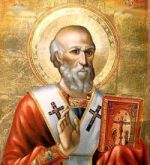Catholic World News News Feature
Irish Opposition to "Pagan" Statute of St. Patrick March 07, 1997
Plans by the Irish government to replace a traditional statue of Ireland's patron saint, St. Patrick, with a modern depiction of a "bald man in a mini-skirt" will apparently be scrapped in the face of local opposition.
The original statue, a famous Irish landmark, was located near Tara in County Meath. Tara is noted as the ancient home of the Irish high kings. St. Patrick arrived at Tara in the 5th century, converted the high king to Christianity, and overthrew the power of the pagan Druids.
The statue of St. Patrick had stood on the same site at Tara for almost a century, proudly symbolizing the Christian conquest of Ireland. One of its fingers was missing-- allegedly shot off by a local Protestant landowner. But the statue remained as the high point of Tara.
However, five years ago the statue was taken down for renovation, having fallen into disrepair. And when it was accidentally damaged further in the process of renovation, the government announced that the statue was beyond repair. A competition was then held to produce a new statue of the nation's patron.
Traditionally St. Patrick is portrayed wearing a green chasuble, wearing a bishop's miter and carrying a bishop's staff or crosier. Often snakes curl around his feet, recalling the legend that he banned all snakes from Ireland. (There are still no snakes in Ireland.) A shamrock is often on display statues of St. Patrick, recalling the saint's use of the native three-leafed plant to explain the mystery of the Holy Trinity to the ancient Druids.
The Irish Government's Office of Public Works supervised a competition for a new statue. The winning design by Annette Hennessy-- chosen in preference to eight other designs-- is anything but traditional: an eight-foot tall bronze representation of a bald man wearing a short dress, carrying a stick topped by antlers in place of a normal crosier.
Hennessy said she had heard somewhere that St. Patrick wore a short tunic to distinguish himself and his followers from the Druids in their long robes. She had also read that St. Patrick once turned himself into a deer to escape pursuers-- hence the antlers. Supporters of her design said that it paid tribute to the pagan background of Tara, as well as the more recent Christian heritage brought by St. Patrick.
But when Hennessy told a meeting of locals that St. Patrick was just a myth and that the story of the shamrock was a 19th-century invention, that was too much. They flatly opposed the new statue, which was due to be erected by St. Patrick's Day, March 17. They dubbed the figure "The Homo on the Hill" and told the government they didn't want it.
For now, the government has taken the position that if the Hennessy statue is not erected, no other statue will be put in its place. Barring a change in that position, St. Patrick may be missing from his traditional place at Tara indefinitely.






